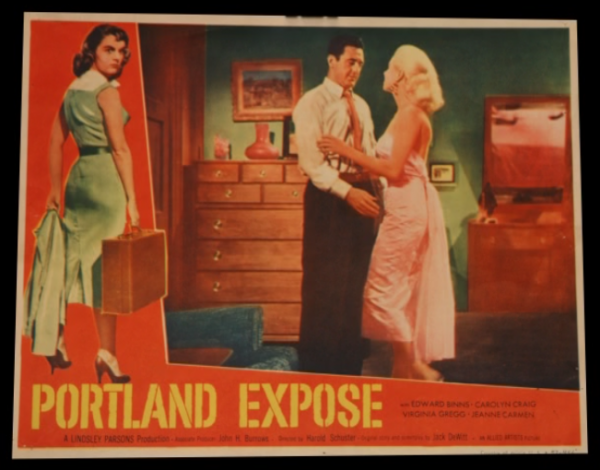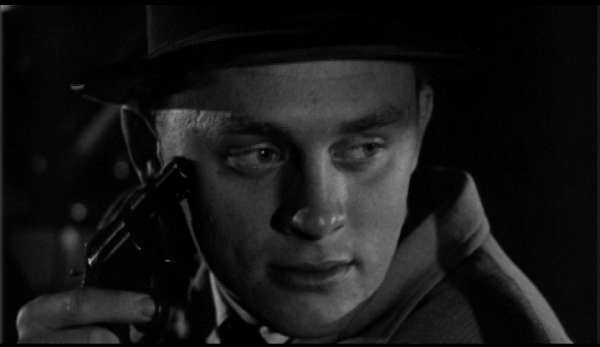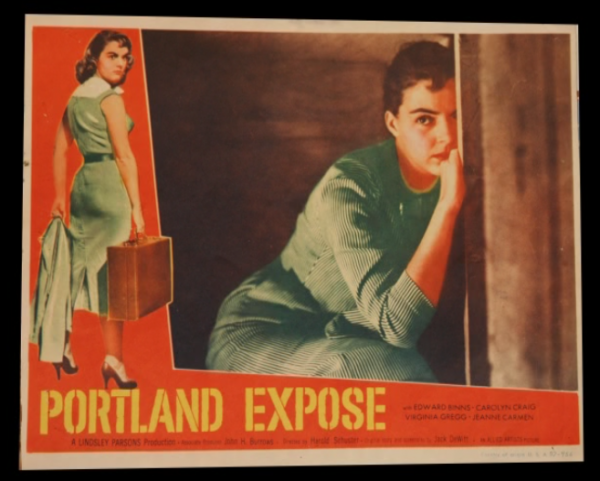This week, continuing in the Noirvember theme, our world takes on a distinctly darker tone and embraces illegal pinball machines the corrupted Portland that found its way into hearing rooms in D.C. before the likes of J. Edgar Hoover and Bobby Kennedy (under the aegis of the McClellan Committee). This is decades before The Polybius Conspiracy took hold of the local gaming world and with much more visceral and evil intents. Raider/Contributor Phil Oppenheim takes us behind the dark and dirty veil of Portland Exposé.

Portland is a cesspool of vice. Shady cops, corrupt labor union leaders, and crooked politicians are in cahoots with gamblers and gangsters and their goons, pinball profiteers and prostitutes. Lock up your kids — especially your teenaged daughters — and hope that someone will someday clean up the rats and racketeers.
At least that grim portrayal of the city might be your takeaway while watching Portland Exposé (1957). Towards the end of the cycle of dark, brooding, morally ambiguous urban mysteries filmmakers turned towards exposes that promised to blow the lid off big- and small-town moral degradation; films like The Phenix City Story, Kansas City Confidential, New Orleans Uncensored, Inside Detroit and others exploited post-war audiences’ fears about the decay of their contemporary society, throwing light on the darkest corners of supposed happy-faced consensus of Eisenhower-era consumer culture. Early film noir imagined a fictional universe of moral complexity, while this genre of late-noir often used real-life criminality and urban decay to depict a culture on the verge of moral collapse.

Writer Jack DeWitt (who also penned 1957’s Oregon Passage) and director Harold Schuster tapped into these fears, using the Portland’s nationally scandalous corruption crisis as proof that even good cities and people perilously close to being turned bad by degenerate forces. The scandal the film uses as its raw material is the notorious pinball-and-prostitution racket that roiled Portland’s local leadership — from the unions to the police to the doorstep of Mayor Terry Schrunk’s office — and wound up dragging Portland’s dirty laundry through the halls of the US Capitol, under the investigative scrutiny of odd bedfellows J. Edgar Hoover and Bobby Kennedy (under the aegis of the McClellan Committee). The details of this sleazy chapter of Portland’s past are endlessly fascinating, and are too complex and twisty to detail here. In short, Portland became a hotbed of all sorts of vice — led by (once-illegal) pinball, but including other kinds of gambling, hookers imported from Seattle, battles between warring criminal syndicates, cops and politicos paid hush-money to keep quiet, burlesque dancers, shady procurers, and much more. If you’re intrigued by any of this — and if you’re not, you should probably be reading somebody else’s column – I strongly recommend reading the historical work of Phil Stanford and Robert Donnelly. Stanford is the unofficial documentarian of the dark days of Portland’s past, and his snappy, tough-guy prose entertainingly mirrors the hardboiled writing and sensibility of the era; Donnelly’s book-length study, Dark Rose: Organized Crime and Corruption in Portland, is an indispensable, richly detailed description and analysis of the entire corruption scandal (if you’re afraid that your weak constitution might not be able to handle Stanford’s full-throttle style, you may want to start with bookishly milder academic accounts of the era, like your friendly neighborhood Raider’s own piece on the subject).
If you can’t tell, I’m a little obsessed with this story — and also with the highly fictionalized, names-changed-to-protect-the-guilty account of Portland Exposé.
The movie’s version of the tale casts Portland as a virginal innocent, preyed upon by a small network of degenerates; unlike what really happened, with question marks still hanging over elected cops, unions, and elected leaders (with Schrunk himself hauled before the McClellan Committee), in the movie version organized labor, the police, and the people’s government representatives collaborate to save the day (and send the bad guys packing). Portland’s order is restored at the film’s end; its implied unspoiled virtue remains (mostly) intact.
What was Portland like in the ‘50s? Our narrator describes it glowingly (if hyperbolically so):
“Portland, Oregon [pronounced here as Ore-A-Gone]. One of the nation’s most beautiful cities. With Mt. Hood rising in the distance, majestic, serene, white with eternal snow. Portland is a city of wide streets, modern buildings, deriving much of its industry from the giant forests of the Northwest.
The citizens of Portland attend many fine churches. Portland is a city of beautiful homes. In this soft climate, gardens grow lush and green throughout the year.
Roses are everywhere in profusion. For years, Portland has been known as the City of Roses. Within easy distance of the city are settings of incomparable natural beauty, such as majestic Multnomah Falls.
It’s a family town. A good place to bring up children. And yet, like the muddy overflow of the Bonneville Dam, crime and ugliness recently swept down on Portland. Like these rushing waters, vice threatened to inundate this jewel of a city.
The events you are about to see happened here — and they could happen again, in your city.”
What Portland is not, the film suggests, is vigilant, however. George, a tough-looking ex-GI with a touch of PTSD who has struck out on his own, starting the rustic, family-friendly Woodland Tavern on the outskirts of town, allows himself to be persuaded to add a pinball machines into his business, on the promise of each machine pulling in $20 a day from visitors. Pinball machines had been illegal in much of the country, and seen as gambling devices with ties to organized crime families, but George is lured by a slick salesman’s pitch of the machine as “just an amusement gadget … clean simple fun” that the kids enjoy; in his heart, though, George knows better, muttering to himself, “you know what a crowd of adults do with those things …” Allowing the pinball machines into his family business is tantamount to inviting the Devil in to dinner with the wife and kids, and soon George’s greedy yielding to temptation becomes a threat to his reputation, his family, and his life — and by extension, his capitulation to sin metaphorically sets Portland itself on a path towards potential destruction.

Portland as a sense of place is mapped out in several location settings (making the film a great window into its midcentury life, and perfect for vicarious-thrill-seeking ‘50s-loving hipsters), including the West side waterfront, the base of the Steel Bridge, views looking eastward from Washington Park to Mt. Hood, The Portland Towers apartment building in Goose Hollow, and more. Much of its most pivotal action, though, takes place in less scenic, more claustrophobic locations, like warehouse basements, apartments, and a cramped reporter’s office; the city’s natural beauty and scenic landmarks are juxtaposed against cramped spaces crammed with criminality, danger, and violence.
George, his wife and two kids—a 17-year-old girl and her bratty brother—are similarly positioned as innocents, soon to be threatened by immoral interlopers. And in the film’s dramatic highlight, the dark malevolence doesn’t just threaten to tear George down, but it also targets his virginal daughter with sexual violence.
This is where Portland Exposé gets really ugly, deeply disturbing, and relentlessly manipulative.
Carolyn Craig plays Ruthie, and although she was 23 at the time of filming she was accustomed to playing younger. Craig explained in a TV Guide article (March 28, 1958), the “illusion” of her looking much younger than her age is something she creates “by a few simple tricks”; when casting directors look at her, “I tell them I’m a grown-up, but they don’t believe me.” Portland Exposé sexualizes Ruthie’s youth, in both the film itself and its promotional campaign, which seems to picture her as a vampy teenage runaway (which never occurs in the movie).
Portland Exposé opposes her carefully crafted underage status against a violent, predatory monster, a gangster goon named Joe—who has previously gotten in trouble with his underworld boss because of his lascivious interest in “young dollies” (as his hood accomplice calls Joe’s past child victims), and some alluded-to violent (and perhaps murderous) attacks in his past. Joe’s evil feels particularly visceral because of Frank Gorshin’s shockingly brutal performance in the role; tapping all of the manic glee of his Riddler (from the beloved Batman series) but none of his camp charm, Joe is a pop-eyed, drooling maniac, incapable of focusing on any of his criminal tasks when schoolgirls are anywhere in sight, abstractedly rubbing his nipples and staring in a psychopathic trance around the “dollies.”

We know the characters are on a collision course as soon as we see Joe, and dread their inexorable meeting. The film taunts us with a distraction first, though. Ruthie is out on a date with Bennie, the Deacon’s son, parked outside of her dad’s tavern, when her boyfriend reaches across the front seat, and grabs her; she’s shocked and frightened, and pulls back. Bennie becomes more forceful: “Stop playing it so square, Ruthie—you know you’ve been around…the place your dad runs…I know where I can get a room …”
Ruthie slaps Bennie and bolts out of the car, but not before Bennie tries to pull her back in, at the cusp of a physical assault. Pinball machines lead vice’s attack on Portland, and even Deacon’s kids are corrupted with their evil influence.
And it gets worse.
A sobbing Ruthie runs towards dad’s Woodland Tavern—and comes face to face with predator Joe. “I don’t mean no harm,” he oozes, “I’m just a friend—that’s it, a friend…” And in the film’s starkest and ugliest moment, he attacks her, and attempts to rape her. No one at the bar hears Ruthie’s screams over the noise of the jukebox and pinball machines, and editor Maurice Wright hammers the film’s theme home by crosscutting Ruthie’s assault with shots of her father counting his ill-gotten gains at the bar’s office; the shocking, brutal scene tortures the audience for an almost unendurable duration—until George finally hears his daughter’s cries for help, runs outside, and beats Joe to a bloody pulp in the nick-of-time.
The scene is pivotal to the film: George realizes that his embrace of pinball-primed greed has been the cause of his family’s near-destruction, and from this moment forward he vows to rid his family of the evil influence, restoring it—and Portland—to its natural purity.
And we’re only halfway through the movie!

It’s probably no surprise to you that George eventually does help clean up the city, thanks to an elaborate wiretap scheme cooked up by decent cops, labor officials, and journalists who want to purge the city of its criminal element. George goes undercover to get the goods on the gangs, but in so doing he winds up engaging in some shady activities himself, including hobnobbing with hookers (and, it’s implied, committing marital infidelity as part of his charade). It all gets pretty tawdry as George descends further into the underworld, but I won’t ruin the lowlights of the plot; you can sink into the gutter with George on your own.
It’s hard to recommend the movie to everyone, exactly, so I hope I’ve been able to forewarn you instead: Portland Exposé is a film noir that borders on becoming an exploitation film. And as fans of exploitation movies know too well, sometimes the sleaziness can rub off on the audience, too.
At the end of Portland Exposé, our narrator returns to tell us briefly about the McClellan Committee’s investigation, asserting that their work into exposing “the cynical men who had abused every trust placed in them by the honest rank-and-file of the unions” successful crushed organized crime in the city: “The rushing torrent of vice receded from the City of Roses. People breathe freely again.” Portland’s purity returns, its would-be violators safely behind bars. The camera pans across the waterfront, bookending the film’s opening, reassuring us that Portland is “still a good place to rear children.” Portland’s virginity has been threatened, but not compromised, its natural beauty unsullied by the temptations of lust, greed, and power: Mt. Hood once again rises “against the distant sky, white and serene beneath its blanket of everyday snow” — symbolically dressed in its God-given virginal bridal white.
It’s a weird movie, and perfect for weird-movie people.

Watch: Portland Exposé is available on a great “Forgotten Noir” 2-movie DVD from Kit Parker Films (the other film is a sleazy white-slavery flick They Were So Young, with Raymond Burr!) . Extras include the lobby cards that are sprinkled throughout this column. I bought mine for under ten bucks years ago, and you can still find plenty of copies available at that price point online from the usual suspects.
Read: In addition to the Stanford and Donnelly texts, students of the era should check out JB Fisher and JD Chandler’s study of the corruption scandal, Portland on the Take: Mid-Century Crime Bosses, Civic Corruption, & Forgotten Murders. It looks great, but your Raider is compelled to disclose that he’s just found out about it and hasn’t read it yet. But that situation will be swiftly remedied.
Visit: Pinball never really left Portland; in fact, Portland is arguably the game’s current world capital. Quarterworld has lots of great games for your enjoyment, including the fantastic Batman ’66 game (my favorite!); videogamers will definitely want to check out both the old-skool Avalon Wunderland nickel arcade and the hip and newly renovated Ground Kontrol. And no tour of Portland’s pinball parlors would be complete without a visit to the amazing Portland Outreach Project’s HQ; they house a fantastic assortment of vintage games, all Ready for Player One.
- Written by Phil Oppenheim


One thought on “RAIDERS OF THE LOST ARCHIVE: Portland Exposé (Harold Schuster, 1957)”